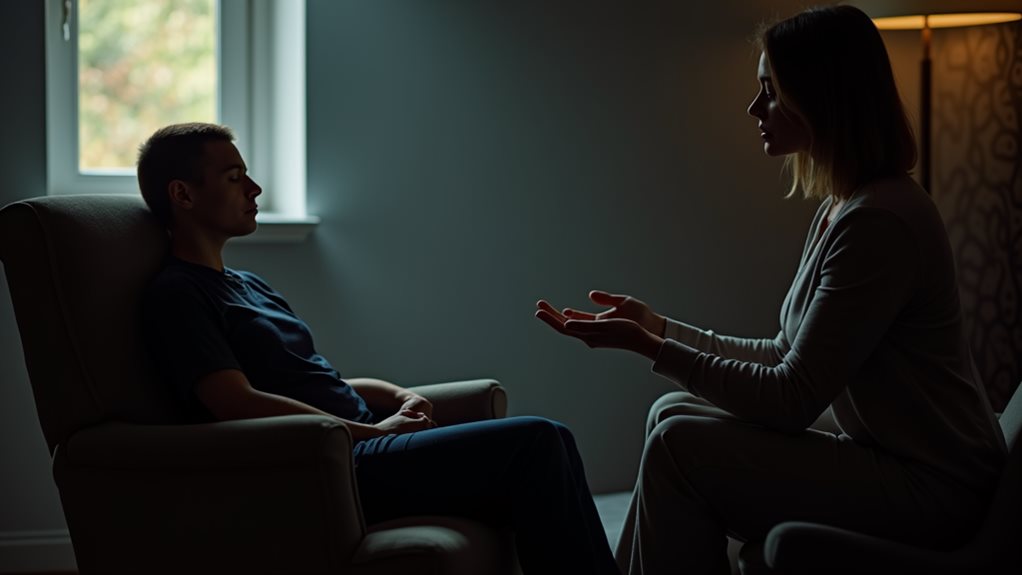
Hypnosis is a profound tool for individuals troubled by terrifying thoughts of ghosts, facilitating access to the subconscious fears that fuel these anxieties. Through techniques like guided visualization and suggestion therapy, sufferers can confront and diminish their fears in a controlled therapeutic environment. This transformative approach not only illuminates the roots of such phobias but also fosters lasting emotional freedom. Exploring further can reveal practical steps for implementing self-hypnosis and achieving peace of mind.
Key Takeaways
- Hypnosis accesses the subconscious to uncover and address the root causes of ghost fears.
- Guided visualization through hypnosis safely confronts and reduces fear of ghosts.
- Suggestion therapy during hypnosis plants positive affirmations to counteract fear.
- Hypnosis leverages relaxation techniques to decrease general anxiety around ghosts.
- Hypnotic sessions provide insights that help manage and often overcome ghost-related fears.
Understanding the Nature of Ghost-Related Phobias
Why do some individuals experience intense fear when they think about ghosts?
Ghost phobia, a common yet deeply personal fear, often stems from a complex interplay of psychological and cultural factors.
The origins of this fear can be traced back to early childhood experiences, tales passed down through generations, or traumatic events that leave a lasting imprint on the psyche.
These fears, although irrational to some, hold significant validity for those affected, manifesting as genuine distress and anxiety.
Understanding the roots of ghost phobia is essential in acknowledging and addressing these intense emotional responses in a compassionate and effective manner.
The Role of Hypnosis in Accessing Subconscious Fears
As a powerful tool for delving into the human psyche, hypnosis provides a unique gateway to accessing subconscious fears, including those associated with ghosts.
Through subconscious exploration, individuals are guided into a hypnotic state where deeper, often unacknowledged, emotions and beliefs surface. This process illuminates the roots of fear manifestation, offering insights into why ghosts provoke such intense reactions.
Techniques of Hypnotherapy for Fear Treatment

Several effective techniques of hypnotherapy are used to treat fears, particularly those related to ghosts. These hypnotic techniques help manage fear by allowing individuals to access and reframe their subconscious perceptions of ghosts. The process involves guided visualization, suggestion therapy, and relaxation techniques, each contributing considerably to fear management. Here's a breakdown of these methods:
| Technique | Description | Impact on Fear |
|---|---|---|
| Guided Visualization | Creates safe encounters with fear stimuli | Reduces anxiety |
| Suggestion Therapy | Implants positive affirmations about ghosts | Alters fear perceptions |
| Relaxation Techniques | Lowers overall stress and anxiety levels | Increases emotional control |
These methods are implemented in a controlled, therapeutic setting, ensuring safety and effectiveness in overcoming ghost-related fears.
EFT Methods for Emotional Release and Balance
Have you ever felt overwhelmed by your fears of the supernatural? Emotional Freedom Techniques (EFT) offer a powerful solution for those haunted by ghostly fears.
EFT tapping, a form of energy healing, uses acupressure techniques to foster emotional balance and fear release.
- EFT Tapping: Activates energy points to alleviate emotional distress.
- Subconscious Healing: Taps into the subconscious to release deep-seated fears.
- Stress Reduction: Reduces anxiety through calming acupressure stimulation.
- Emotional Freedom: Promotes overall well-being by clearing emotional blockages.
Through consistent practice, EFT provides a pathway to emotional freedom, helping individuals achieve a state of balance and peace.
NLP Strategies to Reshape Your Thoughts About Ghosts

Building on the foundation of emotional healing provided by EFT, Neuro-Linguistic Programming (NLP) offers additional tools for those seeking to reshape their thoughts about ghosts. NLP techniques like thought reframing and visualization exercises target subconscious programming, helping to modify emotional triggers and instill empowering beliefs. Through fear desensitization and behavioral changes, individuals can transform their perceptions and reactions towards ghosts.
| Technique | Purpose | Outcome |
|---|---|---|
| Thought Reframing | Alter perception of ghosts | Reduced fear, new perspective |
| Visualization | Mentally rehearse positive encounters | Increased confidence |
| Anchoring | Associate calm with specific cues | Stability in fearful situations |
| Subconscious Programming | Rewire deep-seated fears | Long-term emotional resilience |
| Behavioral Changes | Modify reactions to ghost-related stimuli | Empowered, controlled responses |
Combining Hypnosis, EFT, and NLP for Comprehensive Treatment
While each therapeutic approach—hypnosis, EFT (Emotional Freedom Technique), and NLP (Neuro-Linguistic Programming)—is potent on its own, combining them offers a thorough treatment that addresses multiple facets of fear.
This integration allows for a detailed approach to tackle fear triggers and subconscious beliefs effectively.
- Hypnosis: Accesses and reprograms the subconscious mind.
- EFT: Taps into body's energy system to release emotional disturbances.
- NLP: Reshapes thought patterns and responses to fear.
- Synergistic Effect: Enhances overall efficacy, ensuring a deep and lasting resolution of fears.
This multi-modal strategy empowers individuals to overcome their fears with profound and enduring results.
Practical Steps to Practice Self-Hypnosis at Home

To harness the transformative power of self-hypnosis at home, one must first cultivate a quiet environment conducive to deep relaxation and focused attention.
Initiating the practice involves selecting a comfortable position, either sitting or lying down. The individual then focuses on slow, deep breathing to foster a serene state.
Utilizing self-hypnosis techniques, such as guided imagery, one visualizes a calming scene to deepen the hypnotic state. Consistent home practice enhances proficiency, gradually enabling the practitioner to address deeper fears.
The key is repetition and patience, as mastery of self-hypnosis builds over time, empowering individuals to manage and overcome their phobias effectively.
Embracing a Future Free From the Fear of Ghosts
Embracing a future free from the fear of ghosts begins with understanding that the power to change lies within oneself.
Ghost stories, while intriguing, can undermine one's sense of security and foster irrational fears. By focusing on fear resilience, individuals can reclaim their peace of mind.
- Acknowledge the Impact: Recognize how ghost stories influence feelings and perceptions.
- Cultivate Fear Resilience: Develop strategies to strengthen emotional and psychological defenses.
- Seek Professional Guidance: Consider hypnotherapy or EFT to address deep-seated fears.
- Practice Regularly: Implement learned techniques daily to maintain progress and prevent relapse.
With commitment, a ghost-free future is achievable.
Frequently Asked Questions
Can Hypnosis Inadvertently Increase My Fear of Ghosts?
Hypnosis typically aims to reduce fears by addressing subconscious triggers; however, misconceptions exist that it might inadvertently amplify ghost fear due to improper application or unresolved underlying issues during the therapeutic process.
Are There Age Restrictions for Using Hypnosis to Treat Fears?
Like a wise tree setting boundaries with its roots, hypnosis for treating fears has age considerations. Therapy eligibility generally starts from a certain maturity level, ensuring the individual can effectively engage with the hypnotic process.
How Quickly Can I See Results From EFT for Ghost Fears?
Individuals experiencing ghost fear may observe initial relief through EFT quite quickly, often within a few sessions. However, sustained improvement varies, depending on personal emotional depth and consistency in applying the technique.
Will NLP Conflict With My Existing Psychological Treatments?
NLP techniques generally complement existing psychological treatments rather than conflict with them. Psychological compatibility is key; it's advisable to consult a healthcare professional to guarantee these methods align with one's therapeutic goals.
Are There Any Side Effects to Combining These Therapeutic Approaches?
Combining therapeutic approaches generally enhances treatment efficacy and therapeutic compatibility. However, individual reactions vary; some may experience heightened sensitivity or conflicting emotions, necessitating professional guidance to adjust strategies effectively and safely.
Conclusion
In the end, maybe the real ghosts were the fears we carried inside all along. Through the mystical arts of hypnosis, EFT, and NLP, anyone can become a ghostbuster of the mind, exorcising their spectral anxieties into the ether. Embrace these therapeutic modalities, and you might just find that the only thing that goes bump in the night is your newfound confidence walking fearlessly into the dark. Here's to ghost-free, empowered living!





